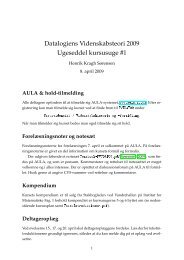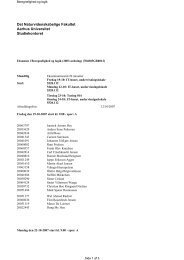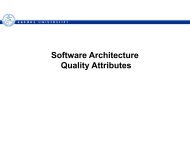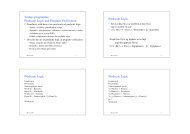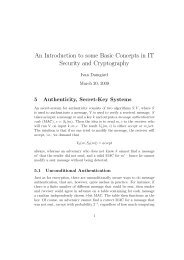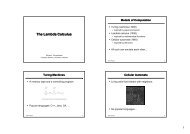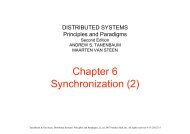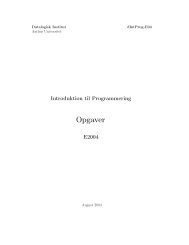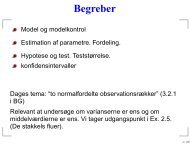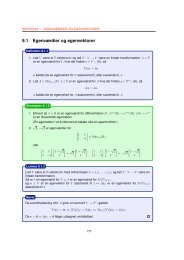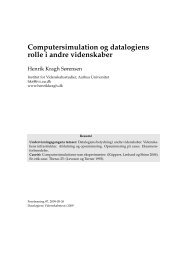Regular safety properties
Regular safety properties
Regular safety properties
You also want an ePaper? Increase the reach of your titles
YUMPU automatically turns print PDFs into web optimized ePapers that Google loves.
Agenda<br />
Concurrency<br />
week 6<br />
Anders Møller<br />
amoeller@daimi.au.dk<br />
• Model checking regular <strong>safety</strong> <strong>properties</strong><br />
with finite-state automata<br />
• Model checking ω-regular <strong>properties</strong><br />
with Büchi automata<br />
2<br />
Model checking<br />
T<br />
the model<br />
(a transition system)<br />
satisfies<br />
Goal: obtain decision procedures for interesting<br />
classes of linear-time <strong>properties</strong><br />
• regular (<strong>safety</strong>) <strong>properties</strong><br />
this week<br />
• ω-regular <strong>properties</strong><br />
• LTL-expressible <strong>properties</strong><br />
next week<br />
P<br />
the property<br />
(a linear-time property)<br />
3<br />
The LTSA approach to <strong>safety</strong> checking<br />
(week 2)<br />
• A <strong>safety</strong> property P defines a deterministic<br />
process that asserts that any trace including<br />
actions in the alphabet of P, is accepted by P<br />
• Algorithm sketch:<br />
1. Compile the FSP model composed with the <strong>safety</strong> property<br />
into a labeled transition system (LTS)<br />
2. Check whether the ERROR state is reachable from the<br />
initial state<br />
3. If reachable, a path corresponds to a counterexample<br />
execution trace; otherwise, the model satisfies the property<br />
Let’s explain this in more detail, using the terminology of [B&K] and regular languages!<br />
4<br />
1
<strong>Regular</strong> <strong>safety</strong> <strong>properties</strong><br />
• Let P be a <strong>safety</strong> property over AP<br />
• Every trace σ that violates P has a finite i bad prefix<br />
ρ∈pref(σ) where ∀θ∈(2 AP ) ω : ρθ∉P<br />
• Let BadPref(P) = { ρ∈pref(σ) | σ∈(2 AP ) ω \P ∧<br />
∀θ∈(2 AP ) ω : ρθ∉P}<br />
• P is a regular <strong>safety</strong> property if BadPref(P) is regular<br />
• The class of regular <strong>safety</strong> <strong>properties</strong> corresponds to<br />
the class of finite-state automata (over the alphabet 2 AP )<br />
5<br />
Example: traffic light<br />
• The following NFA (nondeterministic finite automaton)<br />
accepts the bad prefixes of the <strong>safety</strong> property “a red<br />
phase must be preceded immediately by a yellow phase”<br />
• Let Σ = 2 AP , AP = {yellow, red}<br />
{red}, Ø<br />
{red},<br />
{red, yellow}<br />
q 1 q 0 q 2<br />
{yellow},<br />
Ø<br />
{red, yellow} {yellow}<br />
Ø,<br />
{red},<br />
{yellow},<br />
{red, yellow}<br />
• Note that the atomic propositions are here on<br />
the transitions, not on the states!<br />
6<br />
Checking <strong>safety</strong> <strong>properties</strong><br />
• Let T be a TS and P be a <strong>safety</strong> property<br />
• Define Traces fin (T) = pref(Traces(T))<br />
(i.e. Traces fin (T) is the set of finite prefixes of traces of T)<br />
• Lemma:<br />
T<br />
P ⇔ Traces fin (T) ∩ BadPref(P)=Ø<br />
= Ø<br />
• Proof? (see [B&K] p.114)<br />
Checking regular <strong>safety</strong> <strong>properties</strong><br />
• Let T be a TS and P be a regular <strong>safety</strong> property<br />
• Let A be an NFA with L(A) = BadPref(P)<br />
• T<br />
P ⇔ Traces fin (T) ∩ L(A)= Ø<br />
• To decide this, we first introduce the notion of<br />
invariants…<br />
7<br />
8<br />
2
Invariant <strong>properties</strong><br />
• An invariant is a linear-time property that can<br />
be expressed on the form<br />
{σ 0 σ 1 σ 2 …∈(2 AP ) ω | ∀i: σ i ϕ}<br />
for some propositional logic formula ϕ<br />
(i.e. ϕ contains no temporal operators)<br />
• Example:<br />
MUTEX = {ρ∈(2 AP ) ω | ρ does not contain {crit1, crit2}} }<br />
is the invariant defined by ϕ = ¬crit1 ∧¬crit2<br />
• Every invariant is also a <strong>safety</strong> property (Proof?)<br />
9<br />
Checking invariants and<br />
finding counterexamples<br />
• Let T be a finite TS and P be an invariant<br />
specified by a propositional logic formula ϕ<br />
• T P ⇔ Traces fin (T) ∩ BadPref(P) = Ø<br />
⇔∀σ 0 σ 1 σ 2 …σ n ∈Traces fin (T): σ n ϕ<br />
• If ∃σ 0 σ 1 σ 2 …σ n ∈Traces fin (T): σ n ϕ<br />
then ∀θ∈(2 AP ) ω : σ 0 σ 1 σ 2 …σ n θ P<br />
(i.e. σ 0 σ 1 σ 2 …σ n θ is a counterexample for any θ)<br />
• Algorithm: breadth-first search through T<br />
for a state where ϕ is violated… (see [B&K] Sec.3.3.1)<br />
10<br />
A reduction from regular <strong>safety</strong><br />
checking to invariant checking<br />
• Given a TS T andanNFAA A with alphabet 2 AP<br />
we want to construct a TS T⊗A such that<br />
Traces fin (T) ∩ L(A)= Ø<br />
⇔<br />
T⊗A P inv(A)<br />
where P inv(A) is an invariant that depends on A<br />
• (We’ll define P inv(A) soon…)<br />
11<br />
T<br />
next<br />
next<br />
s1<br />
{yellow}<br />
s0<br />
Ø<br />
s2<br />
{red}<br />
Example: traffic light<br />
next<br />
s3<br />
{yellow}<br />
next<br />
{yellow},<br />
{red, yellow}<br />
A<br />
{red}, Ø<br />
q 1 q 0<br />
{red},<br />
{red, yellow}<br />
q 2<br />
{yellow}<br />
T⊗A<br />
(showing reachable states only)<br />
NOTE: the example in the book is flawed <br />
Ø<br />
(s0, q 0 )<br />
q 0<br />
next<br />
next (s3, q 1 )<br />
q 1<br />
next<br />
(s1, q 1 )<br />
q 1 next<br />
(s2, q 0 )<br />
q 0<br />
Ø,<br />
{red},<br />
{yellow},<br />
{red, yellow}<br />
12<br />
3
Product of TS and NFA<br />
• Let T = (S, Act, , I, AP, L) be a TS (without terminal states,<br />
as usual) and A = (Q, Σ, δ, Q 0 , F) be an NFA (in this version,<br />
having a set of initial states) where Σ = 2 AP and Q 0 ∩ F = Ø<br />
• The product transition system T⊗A is the TS<br />
(S’, Act, ’, I’, AP’, L’) where<br />
– S’ = S × Q<br />
(s, α, t)∈ p∈δ(q, L(t))<br />
– ’ is defined by:<br />
((s, q), α, (t, p))∈ ’<br />
– I’ = { (s 0 , q) | s 0 ∈I ∧∃q 0 ∈Q 0 : q∈δ(q 0 , L(s 0 )) }<br />
– AP’ = Q<br />
– L’(s, q) = {q} for all s∈S and q∈Q<br />
13<br />
The invariant P inv(A)<br />
• Choose P inv(A) as the invariant defined by<br />
∧ q∈F ¬q (where F is the accept states of A)<br />
• This invariant is satisfied if none of A’s<br />
accept states are reachable in T⊗A<br />
14<br />
Putting the pieces together…<br />
Example: traffic light<br />
• Let T be a TS over AP, let P be a regular <strong>safety</strong><br />
property over AP, and dlet tAA be an NFA where<br />
L(A) = BadPref(P)<br />
• Theorem:<br />
The following statements are equivalent:<br />
a) T P<br />
b) Traces fin (T) ∩ L(A)= Ø<br />
c) T⊗A P inv(A)<br />
• Proof? (see [B&K] p.167)<br />
15<br />
T⊗A<br />
(s0, q 0 )<br />
q 0<br />
next (s3, q 1 )<br />
q 1<br />
next<br />
next<br />
(s1, q 1 )<br />
q 1 next<br />
(s2, q 0 )<br />
q 0<br />
• T⊗A has no reachable state whose label is an<br />
accept state in A<br />
• so we conclude that T<br />
P ☺<br />
16<br />
4
Summary of model checking for<br />
regular <strong>safety</strong> <strong>properties</strong><br />
Classification of LT <strong>properties</strong><br />
Let T be a finite TS and let P be a regular <strong>safety</strong> property<br />
described by an NFA A (i.e. L(A) = BadPref(P))<br />
1. Construct T⊗A<br />
2. If T⊗A has a reachable state (s, q) where q is an<br />
accept state in A, then report “NOT SATISFIED!”,<br />
find a (shortest possible) path from the initial state<br />
to such a state, and report the corresponding trace<br />
fragment as a counterexample<br />
3. Otherwise, report “SATISFIED!”<br />
17<br />
regular <strong>safety</strong> <strong>properties</strong><br />
• Not all <strong>safety</strong> <strong>properties</strong> are regular<br />
• (Study this in exercises….)<br />
<strong>safety</strong> and liveness<br />
property (2 AP ) ω<br />
<strong>safety</strong> <strong>properties</strong><br />
neither liveness<br />
nor <strong>safety</strong><br />
<strong>properties</strong><br />
(but intersection i of…)<br />
liveness <strong>properties</strong><br />
18<br />
Agenda<br />
The LTSA approach to progress checking<br />
with ‘fair choice’ (week 2)<br />
• Model checking regular <strong>safety</strong> <strong>properties</strong><br />
with finite-state automata<br />
• Model checking ω-regular <strong>properties</strong><br />
with Büchi automata<br />
1. Compile the FSP program into a labeled<br />
transition system (LTS)<br />
1. Search for terminal sets (A set of states S is a terminal set<br />
if every state in S is reachable from every other state in S via<br />
one or more transitions, and there is no transition from within<br />
S to any state outside S)<br />
2. Check for each terminal set that t at least one of<br />
the progress set actions occurs as a transition<br />
(if not, report a path to the terminal set and its actions)<br />
Let’s generalize this to encompass “regular” liveness <strong>properties</strong>, using the [B&K] terminology<br />
19<br />
20<br />
5
Model checking liveness <strong>properties</strong><br />
Büchi automata<br />
• An LT property P is a liveness property if<br />
pref(P) = (2 AP )*<br />
• Liveness is fundamentally about infinite traces,<br />
so ordinary automata (that accept sets of finite<br />
strings) are useless here<br />
• Let’s introduce a kind of automata that<br />
work on sets of infinite strings!<br />
21<br />
A nondeterministic Büchi automaton (NBA) is<br />
a 5-tuple (Q, Σ, δ, Q 0 , F) where<br />
• Q is a finite set of states<br />
• Σ is an alphabet<br />
• δ: Q ×Σ→2 Q is a transition function<br />
• Q 0 ⊆ Qis a set of initial states<br />
• F ⊆ Q is a set of accept states<br />
– so far, it looks just like an NFA!<br />
22<br />
The language of a Büchi automaton<br />
Example<br />
• Let A = (Q, Σ, δ, Q 0 , F) be an NBA and σ = a 0 a 1 a 2 …∈Σ ω<br />
• A run for σ is an infinite sequence of states q 0 q 1 q 2 …<br />
where<br />
– q 0 ∈Q 0 and<br />
– q i+1 ∈δ(q i , a i ,) for all i<br />
• Such a run is accepted by A if q i ∈F for infinitely many i<br />
• The language of A, denoted L(A), is the set of infinite<br />
strings σ∈Σ ω where some run is accepted by A<br />
What is the language of this Büchi automaton?<br />
b<br />
q 0 q 1<br />
a<br />
a<br />
b<br />
23<br />
24<br />
6
Nonblocking NBA<br />
• An NBA (Q, Σ, δ, Q 0 , F) is is nonblocking if<br />
δ(q, a)≠Ø ) Øfor all q∈Q and a∈ΣΣ<br />
• For a nonblocking NBA, every infinite string<br />
over the same alphabet has at least one run<br />
• We can assume without loss of generality that<br />
our NBAs are nonblocking (Why?)<br />
25<br />
ω-regular expressions<br />
• As a variant of Kleene’s theorem, Büchi automata<br />
correspond to “ω-regularω expressions”!<br />
• An ω-regular expression G over Σ has the form<br />
G = E 1 F ω 1 + … + E n F<br />
ω n<br />
where E 1 , …, E n , F 1 , …, F n are (ordinary) regular<br />
expressions over Σ and Λ∉L(F i ) for all i<br />
• The language of G is<br />
L(G) = L(E 1 )⋅L(F 1 ) ω ∪ … ∪ L(E n )⋅L(F n ) ω<br />
• A language L⊆Σ ω is ω-regular if it is the language<br />
of some ω-regular expression<br />
26<br />
Properties of Büchi automata<br />
and ω-regular languages<br />
• L⊆Σ ω is ω-regular iff it is the language of<br />
some NBA (Theorem 4.32 in [B&K], exercises…)<br />
Example<br />
What is an ω-regular expression that has the<br />
same language as this Büchi automaton?<br />
• The class of ω-regular languages is closed<br />
under union (trivial), intersection (next week),<br />
and complement (difficult!)<br />
• Deterministic Büchi automata are strictly less<br />
expressive than nondeterministic Büchi automata!<br />
• Minimizing Büchi automata is PSPACE-hard<br />
(but heuristics exist)<br />
27<br />
c<br />
b<br />
a<br />
b<br />
q 1 q 2 q 3<br />
b<br />
Hint: it must have the form E 1 F 1 ω + … + E n F n<br />
ω<br />
c*ab(b + + bc*ab) ω<br />
28<br />
7
ω -regular <strong>properties</strong><br />
• Let P be a linear-time property over AP<br />
• P is an ω-regular property if it is an<br />
ω-regular language<br />
• (Compare with the definition of regular <strong>safety</strong> property)<br />
<strong>Regular</strong> vs. ω-regular?<br />
• Any regular <strong>safety</strong> property P is also an<br />
ω-regular property!<br />
• Proof?<br />
The complement of P,<br />
(2 AP ) ω \P = BadPref(P)⋅(2 AP )<br />
ω<br />
is ω-regular, and the class of ω-regular<br />
languages is closed under complement<br />
29<br />
30<br />
Examples (from last week)<br />
• Peterson:<br />
– “Each process will eventually enter its critical region”<br />
– “Each process will enter its critical region infinitely often”<br />
– “Each waiting process will eventually enter its critical region”<br />
• Vending machine:<br />
– “The machine will always eventually serve a drink”<br />
– “The machine will always eventually serve coffee”<br />
• Are these liveness <strong>properties</strong> all ω-regular?<br />
Checking ω-regular <strong>properties</strong><br />
• Let T be a TS and P be an ω-regular property<br />
• T P ⇔ Traces(T) ∩ (2 AP ) ω \P = Ø<br />
• For regular <strong>safety</strong> <strong>properties</strong>, we introduced<br />
invariants and reduced regular <strong>safety</strong> checking<br />
to invariant checking<br />
• Now, we introduce persistence <strong>properties</strong> and<br />
reduce ω-regular checking to persistence checking!<br />
31<br />
32<br />
8
Persistence <strong>properties</strong><br />
• An persistence property is a linear-time<br />
property that t can be expressed on the form<br />
{σ 0 σ 1 σ 2 …∈(2 AP ) ω | ∃i: ∀j≥i: σ j ϕ}<br />
for some propositional logic formula ϕ<br />
• i.e. “ϕ is an invariant after a while”<br />
Checking persistence <strong>properties</strong><br />
and finding counterexamples<br />
• Let T = (S, Act, , I, AP, L) be a finite TS and P be a<br />
persistence property specified by a propositional<br />
logic formula ϕ<br />
• Theorem: T P ⇔<br />
∃s 0 s 1 s 2 …s k …s n ∈S*: s 0 ∈I ∧∀0≤i
Product of TS and NBA<br />
• Let T = (S, Act, , I, AP, L) be a TS and<br />
A = (Q, Σ, δ, Q 0 , F) be a nonblocking NBA<br />
where Σ = 2 AP<br />
• The product transition system T⊗A is defined<br />
exactly as for an NFA!<br />
The persistence property P pers(A)<br />
• Choose P pers(A) as the persistence property p defined by<br />
∧ q∈F ¬q (where F is the accept states of A)<br />
(the same formula as for P inv(A) )<br />
• This property is satisfied if A’s s accept states are<br />
visited only finitely many times in any execution<br />
of T⊗A<br />
37<br />
38<br />
Putting the pieces together…<br />
Summary of model checking for<br />
ω-regular <strong>properties</strong><br />
• Let T be a TS over AP, let P be an ω-regular<br />
property over AP, and dlet tAA be a nonblocking<br />
NBA where L (A) = (2 AP ) ω \P<br />
• Theorem:<br />
The following statements are equivalent:<br />
a) T P<br />
b) Traces(T) ∩ L(A)= Ø<br />
c) T⊗A P pers(A)<br />
• Proof? (see [B&K] p.201)<br />
39<br />
Let T be a finite TS and let P be a ω-regular property<br />
described by a nonblocking NBA A (i.e. L(A) = (2 AP ) ω \P )<br />
1. Construct T⊗A<br />
2. If T⊗A has a reachable state (s, q) where q is an<br />
accept state in A and (s, q) is on a cycle, then report<br />
“NOT SATISFIED!”, find a path from the initial state<br />
to such a state and the cycle back to the state, and<br />
report the corresponding trace fragments as a<br />
counterexample<br />
3. Otherwise, report “SATISFIED!”<br />
40<br />
10
T<br />
Example: another traffic light<br />
s2<br />
Ø<br />
on<br />
off<br />
s0<br />
{red}<br />
next<br />
next<br />
A<br />
s1<br />
{green}<br />
nonblocking NBA for<br />
the complement of<br />
P=“infinitely often green”<br />
AP {red}, Ø<br />
2 AP<br />
2<br />
q 0<br />
{red}, Ø<br />
q 1<br />
{green},<br />
{red, green}<br />
q 2<br />
Classification of LT <strong>properties</strong><br />
ω-regular <strong>properties</strong><br />
<strong>safety</strong> and liveness<br />
property (2 AP ) ω<br />
<strong>safety</strong> <strong>properties</strong><br />
T⊗A<br />
(s2, q 0 )<br />
q 0<br />
on<br />
(s2, q 1 )<br />
q 1<br />
(s2, q 2 )<br />
q 2<br />
on off<br />
on off<br />
on off<br />
(s0, q 0 ) off (s0, q 1 )<br />
(s0, q 2 )<br />
q 0<br />
next q 2<br />
next next next<br />
next next<br />
(s1, q 0 ) next (s1, q 1 )<br />
(s1, q 2 )<br />
q 0 q 1<br />
q 2<br />
conclusion: T<br />
P<br />
41<br />
neither liveness<br />
nor <strong>safety</strong><br />
<strong>properties</strong><br />
(but intersection i of…)<br />
liveness <strong>properties</strong><br />
• Compare with earlier slides about “Classification of LT <strong>properties</strong>”!<br />
• (Exercise: compare linear-time / <strong>safety</strong> / liveness / invariants / progress /<br />
persistence / LTL / regular / ω -regular <strong>properties</strong>)<br />
42<br />
Summary<br />
• Model checking with regular <strong>safety</strong> <strong>properties</strong> can be done<br />
with ordinary finite automata by a reduction to<br />
invarianti model checking<br />
– product of the TS and an NFA representing the bad<br />
prefixes of the property<br />
– e.g. breadth-first search<br />
• Model checking with ω-regular <strong>properties</strong> can be done<br />
with Büchi automata by a reduction to persistence property<br />
model checking<br />
– product of the TS and an NBA representing the<br />
complement of the property<br />
– e.g. nested depth-first search<br />
43<br />
11
Concurrency – week 6<br />
• Model checking regular <strong>safety</strong> <strong>properties</strong><br />
with finite-state automata<br />
• Model checking ω-regular <strong>properties</strong><br />
with Büchi automata<br />
t<br />
Let P be a linear-time property over AP<br />
• P is a <strong>safety</strong> property if<br />
∀σ∈(2 AP ) ω \P: ∃ρ∈pref(σ): ∀θ∈(2 AP ) ω : ρθ∉P<br />
• P is a liveness property if pref(P) = (2 AP )*<br />
• P is a regular <strong>safety</strong> property if BadPref(P) is regular<br />
• P is an invariant if it can be expressed on the form<br />
{σ 0 σ 1 σ 2 …∈(2 AP ) ω | ∀i: σ i ϕ}<br />
for some propositional logic formula ϕ<br />
• P is an ω-regular property if it is an ω-regular language<br />
• P is a persistence property if it can be expressed on the<br />
form {σ 0 σ 1 σ 2 …∈(2 AP ) ω | ∃i: ∀j≥i: σ j ϕ}<br />
for some propositional logic formula ϕ<br />
12



